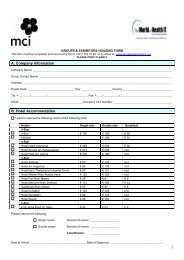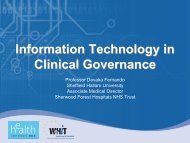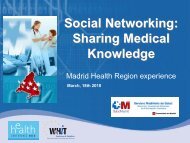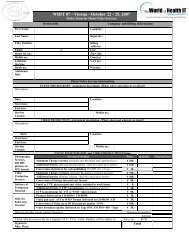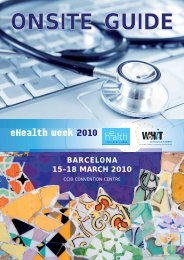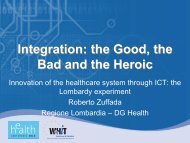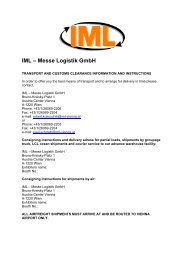Patients' Empowerment Challenges and opportunities Challenges ...
Patients' Empowerment Challenges and opportunities Challenges ...
Patients' Empowerment Challenges and opportunities Challenges ...
Create successful ePaper yourself
Turn your PDF publications into a flip-book with our unique Google optimized e-Paper software.
Patients’ <strong>Empowerment</strong><strong>Challenges</strong> <strong>and</strong> <strong>opportunities</strong>from older people’s perspectiveBudapest, Hungary10 – 12 May 2011
Dr. Liz MestheneosPresident of AGE Platform Europe
Content• AGE Platform Europe at a glance• Opportunities of e‐Health for older people as…‐Patients‐ Carers‐ Citizens/consumers• <strong>Challenges</strong>‐ Accessibility <strong>and</strong> affordability‐ Ethical <strong>and</strong> legal issues‐ User Involvement‐ Digital Literacy‐ Interoperability• Conclusion
AGE Platform Europe at a glance• AGE Platform Europe aims to voice <strong>and</strong> defend the interest ofolder people <strong>and</strong> to raise awareness on issues that concernsthem like age discrimination, active ageing, pensions, socialexclusion, health, ICT <strong>and</strong> accessibility to transport <strong>and</strong> builtenvironment.• Concerning eHealth, AGE follows this issues from a policyperspective, p e.g. involvement in the eHealth Users StakeholderGroup, contribution to the discussion on the Digital Agenda forEurope• In addition, AGE is involved in different projects at EU level,e.g. Dreaming, OASIS, Home Sweet Home4
Opportunities of e‐Health forolder people as…• Patients• Carers• Citizens/Consumers=> Situations are very different <strong>and</strong> so are the needs,<strong>opportunities</strong> <strong>and</strong> challenges. It should be underlined <strong>and</strong>reminded that e‐health technologies are a tool <strong>and</strong> only atool.
Opportunities of e‐Health eafor olderodepeople as patientAgain older people as patient shouldn’t be seen as anhomogeneous group. They might be patients in day carecentres, in hospitals, in residential homes, at home, etc.• medical records e.g. to tackle poly‐medication <strong>and</strong> adversereaction due to negative interactions• tele‐medicines e.g. for daily checks in case of chronicdiseases, for people living in remote areas• coordination i between social il<strong>and</strong> health hcare services <strong>and</strong>family carers, e.g. residential homes <strong>and</strong> hospitals in case oftransfer6
Opportunities of e‐Health for olderpeople as carers• Some figures about family/informal carers‐ around 25% of the inhabitants of the EU countries‐ carers are mostly women‐ mean age of carers is 55• e‐Health application might help to alleviate the burden, givemore space for more interaction, reassure the carer who is notable to be present 24/24, 7/7=> Tki Taking informal/family il carers into consideration whenreflecting on eHealth for the future is essential7
Opportunities of e‐Health eafor odeolderpeople as citizens/consumers• Being old is not a synonym of being a patient, or beingsick! In addition, e‐Health technologies could be used toenhance health prevention.• Older people might look for information not only on care<strong>and</strong> cure but as well on prevention. They might look forinformation on their health insurance systems(public/private), on hospitals, residential homes, home careservices, smart applications to anticipate future needs.=> In that case, the issue at stake is the use of Internet butthis is part of the wholde eHealth system.8
<strong>Challenges</strong>Despite the heterogeneity among older people as users ofe‐Health application, they are common challenges• Accessibility <strong>and</strong> affordability• Ethical <strong>and</strong> legal issues• User involvement• Digital literacy• Interoperability9
Accessibility <strong>and</strong> affordability• For e‐health products that have to be used by olderpeople/patients themselves or by their carers, accessibility<strong>and</strong> usability is key => design for all should be the keyprinciple to avoid new gaps.• Affordability is at stake as well, again to avoid gaps <strong>and</strong>exclusion: e‐Health technologies should be made availablefor everyone to support improvement of quality oflife/care.• Support: it is very important to provide help hl to the personwhen needed during the use of the device.10
Ethical <strong>and</strong> legal issues• There are still ethical issues that need to be address, e.g. egwhen the e‐health technology is used by an informal/familycarer who can access to “confidential” data.• Data protection should be considered especially in thecross‐border context <strong>and</strong> to balance interests ofprofessionals <strong>and</strong> patients.• Legal liability of e‐Health products should be betterexamined, e.g. who is responsible in case of failure of analarm system.11
User involvement• To use the motto of the European Disability Forum“Nothing for us, without us” <strong>and</strong> to implement the Designfor all principle.• User involvement should be done at an early stage: notonly to validate e‐health products but to define users’needs from the beginning.g12
Digital Literacy• Besides accessibility <strong>and</strong> usability of e‐health products,this is a pre‐requisite for the use of these technologies.• Digital Literacy encompasses the ability to use thetechnology but as well the ability to underst<strong>and</strong> <strong>and</strong>benefit from the technology to take informed decisions.• In e‐Health, this second element is very importantallowing a better acceptance <strong>and</strong> trust.13
Interoperability• Interoperability is a key issue to have e‐healthtechnologies that effectively deliver better integrated care,e.g. better coordination between healthcare professionalsbut as well between social <strong>and</strong> health care <strong>and</strong> familycarers.• In addition to interoperability of systems, interoperabilityof products should be better ensured to have an effectivescale up of eHealth technologies, i.e. different devices orprogrammes should be able to speak to each others.14
Conclusione‐Health technologies are tools that offer wide<strong>opportunities</strong> <strong>and</strong> complementary supports to beconsidered in a context of demographic ageing.Besides current running projects, AGE will continue to bringolder people’s perspective on eHealth notably via:• Its involvement in the Steering group of the EuropeanInnovation Partnership on Active <strong>and</strong> Healthy Ageing• The European Year 2012 on active ageing <strong>and</strong> solidaritybetween generations15
Thank you for your attentionAGE Platform EuropeRue Froissart 1111040 Brussels – Belgiumtel. : +32.2.280.14.70fax : +32.2.280.15.22www.age‐platform.eu16




